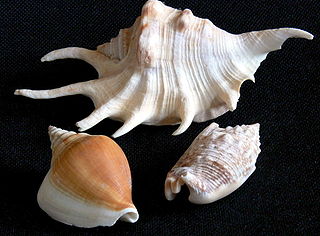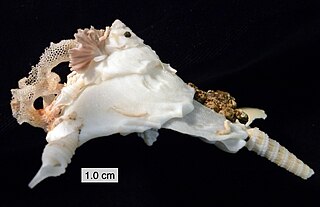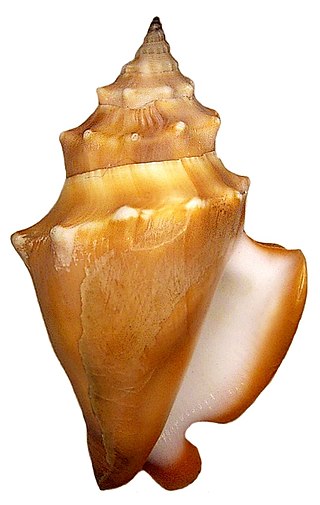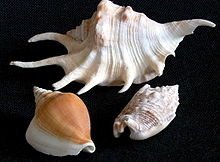
Strombidae, commonly known as the true conchs, is a taxonomic family of medium-sized to very large sea snails in the superfamily Stromboidea, and the Epifamily Neostromboidae. The term true conchs, being a common name, does not have an exact meaning. It may generally refer to any of the Strombidae but sometimes is used more specifically to include only Strombus and Lambis. The family currently includes 26 extant, and 10 extinct genera.

Aliger gigas, originally known as Strombus gigas or more recently as Lobatus gigas, commonly known as the queen conch, is a species of large sea snail, a marine gastropod mollusc in the family of true conches, the Strombidae. This species is one of the largest molluscs native to the Caribbean Sea, and tropical northwestern Atlantic, from Bermuda to Brazil, reaching up to 35.2 centimetres (13.9 in) in shell length. A. gigas is closely related to the goliath conch, Lobatus goliath, a species endemic to Brazil, as well as the rooster conch, Aliger gallus.

Strombus is a genus of medium to large sea snails, marine gastropod molluscs in the family Strombidae, which comprises the true conchs and their immediate relatives. The genus Strombus was named by Swedish Naturalist Carl Linnaeus in 1758. Around 50 living species were recognized, which vary in size from fairly small to very large. Six species live in the greater Caribbean region, including the queen conch, Strombus gigas, and the West Indian fighting conch, Strombus pugilis. However, since 2006, many species have been assigned to discrete genera. These new genera are, however, not yet found in most textbooks and collector's guides.

Littorinimorpha is a large order of snails, gastropods, consisting primarily of sea snails, but also including some freshwater snails and land snails.

Cypraeoidea, the cowries and cowry allies, is a superfamily of sea snails, marine gastropods included in the clade Littorinimorpha. This superfamily had been called Cypraeacea and was named by Rafinesque in 1815.

Xenophoridae, commonly called carrier shells, is a family of medium-sized to large sea snails, marine gastropod mollusks in the clade Littorinimorpha.

Lobatus raninus, common name the hawk-wing conch, is a species of medium to large sea snail, a marine gastropod mollusk in the family Strombidae, the true conchs.

Strombus alatus, the Florida fighting conch, is a species of medium-sized, warm-water sea snail, a marine gastropod mollusk in the family Strombidae, the true conchs. Its name derives two Latin words. Strombus means, in Latin, a snail with spiral shell, which derives from the Greek στρόμβος, meaning anything turned or spun around, like a top or, as in Aristotle's Historia Animalium, a sea snail. Alatus means, in Latin, "winged".

Conomurex luhuanus, commonly known as the strawberry conch or tiger conch, is a species of medium-sized sea snail, a marine gastropod mollusk in the family Strombidae, the true conchs. C. luhuanus is found in sandy habitat among corals in the Indopacific region. They feed on algae or detritus, move with a modified foot, and have complex eyes compared to other gastropods.

Titanostrombus goliath, previously known as Lobatus goliath and Strombus goliath, common name the goliath conch, is a species of very large edible sea snail, a marine gastropod mollusk in the family Strombidae, the true conchs. T. goliath is one of the largest mollusks of the Western Atlantic Ocean, and also one of the largest species among the Strombidae. It was once considered endemic to Brazil, but specimens have also been recently found in the waters of Barbados. Brazilian common names for this species include búzio de chapéu or búzio, and búzio de aba or buzo in. Some phylogenetic hypotheses consider T. goliath as closely related to the queen conch, Aliger gigas.

Aliger gallus, previously known as Strombus gallus, common name the rooster conch or rooster-tail conch, is a species of medium-sized sea snail, a marine gastropod mollusk in the family Strombidae, the true conchs.

Labiostrombus epidromis, common name the swan conch, is a species of sea snail, a marine gastropod mollusk in the family Strombidae, the true conchs.

Sinustrombus sinuatus, common name the laciniate conch, is a species of sea snail, a marine gastropod mollusc in the true conch family, Strombidae. It is native to the tropical Indo-Pacific region.

Terebellum terebellum, common name the Terebellum conch, is a species of sea snail, a marine gastropod mollusk in the family Seraphsidae, the true conchs.

Tibia insulaechorab, common name the Arabian tibia, is a species of sea snail, a marine gastropod mollusk in the family Rostellariidae. It is native to the Red Sea and the Horn of Africa.

Strombus gracilior, common names the Eastern Pacific fighting conch, or the Panama fighting conch, is a species of medium to large sea snail, a marine gastropod mollusk in the family Strombidae, the true conchs.

Rostellariidae is a family of sea snails, marine gastropod molluscs in the clade Littorinimorpha.

Titanostrombus galeatus, commonly known as the Eastern Pacific giant conch, is a species of large sea snail, a marine gastropod mollusk in the family Strombidae, the true conchs and their allies.

Lobatus peruvianus, commonly known as the Peruvian conch or the cock's comb conch, is a species of large sea snail, a marine gastropod mollusk in the family Strombidae, the true conchs and their allies.

Varicospira cancellata, common name the cancellated beak shell, is a species of sea snail, a marine gastropod mollusk in the family Rostellariidae, the true conchs.
























